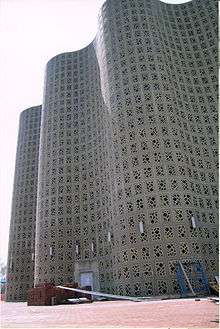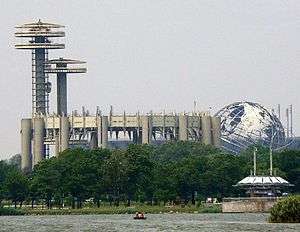New York Hall of Science
 Original building, constructed for the 1964 New York World's Fair | |
| Established | 1964 |
|---|---|
| Location |
47-01 111th Street Corona, New York |
| Coordinates | 40°44′50″N 73°51′06″W / 40.7472°N 73.8517°WCoordinates: 40°44′50″N 73°51′06″W / 40.7472°N 73.8517°W |
| Type | Science-technology museum |
| Accreditation | ASTC |
| President | Margaret Honey |
| Curator | Lee Livney |
| Public transit access |
Q23, Q58 at 108th Street Q48 at Roosevelt Avenue |
| Nearest car park | On-site ($10 fee) |
| Website |
nysci |
The New York Hall of Science, also known as NYSCI, is a science museum located in Flushing Meadows-Corona Park in the New York City borough of Queens, in the section of the park that is in Corona. It occupies one of the few remaining structures from the 1964 New York World's Fair, and is New York City's only hands-on science and technology center. The more than 400 hands-on exhibits focus on biology, chemistry, and physics.
History
Founding and deterioration
The museum was established in 1964 as part of the 1964 World's Fair in Flushing Meadows-Corona Park,[1][2] and at the time was one of only a few science museums in existence.[3] Unlike many other institutions, which were closed immediately or soon after the Fair,[4] the Hall remained open after the fair, and served as a resource for students.[5] Its exhibits at the time were somewhat limited but included plans for the world's first atomarium open to the public.[6]
The Hall remained open for 15 years, but in 1979 it was closed for major renovations, not to reopen until 1983 at the earliest. By May 1982, according to a New York Daily News article at the time, the condition of the museum had deteriorated to such a state that there were "paint peels from the Saturn V and Apollo hulls, and graffiti adorn the walls around the space park; chipped cement and scattered stones fill the moat beneath the hall". At the time, even though renovations were completed in 1983, city funding for the museum was severed because only $40,000 out of $8,000,000 of promised funding had been raised.[7]
In 1984, New York City hired physicist Alan Friedman to help with the museum's transition[3] from a focus on science fiction to relevance to everyday lives of ordinary citizens.[8] At the time Friedman was appointed, the museum was basically an empty shell, having "an inch of water on the floor. All the exhibits had been given away. Even the light fixtures had been yanked out of the wall”, but renovations continued.[7] After it reopened in 1986, giving New York City a science museum for the first time since it had closed seven years earlier,[9] plans for the display of an atom were realized with a $40,000 exhibit for a quantum atom that was a part of a $400,000 expansion and renovation at the museum.[10] The museum's growth and ability to draw crowds was unexpected and led to the city's pursuit of further funds and expansion.[11]
At the time of its re-opening, the museum was unique in that it also provided a training program for science majors who could then go on to study under a tuition waiver program at nearby Queens College[12] in exchange for committing to spend at least two years in city schools who needed science educators.[13]
The museum's role in the life of city school children continued, and in 1991 it announced plans for a ten-year, $80 million renovation and expansion to be able to meet the needs of a growing visitorship.[1] Further expansion, which included a new entrance rotunda, driveway, cafe, gift shop and theater, as well as a 30,000-square-foot (2,800 m2) science playground, began in 1996[3] and reflected the need for constant updates in science museums to keep their displays up to date and relevant. In recognition of its continued upgrading, the Hall was granted the status of a New York City cultural institution, given to a limited number of organizations.[14]
Funding
In 2005, the Hall was among 406 New York City arts and social service institutions to receive part of a $20 million grant from the Carnegie Corporation, which had been made possible through a donation by New York City mayor Michael Bloomberg.[16][17] The Hall has continued to receive funding from a number of sources essential to its operation and expansion.[18][19] This represented a welcome change for the museum from the 1990s during which severe cuts in funding threatened its ability to operate successfully.[20]
Exhibits

The Hall mainly focuses on education for children ages 1–17 and its audience consists primarily of city children for whom the exposure to science is something new.[13] The museum includes a large permanent collection[21] as well as a range of travelling exhibitions. Although somewhat more common now, the museum was among the first to have its young visitors assess its exhibits and it welcomed their feedback in preparation for the re-opening in 1986.[22] The Hall's permanent exhibitions include:
- Connections: The Nature of Networks
- Feedback
- Gingerbread Lane
- Hidden Kingdoms: The World of Microbes[23]
- Mathematica: A World of Numbers... and Beyond
- Marvelous Molecules- The Secret of Life
- Preschool Place
- Realm of the Atom
- Rocket Park[8]
- Science Playground[24]
- Science Technology Library
- The Search for Life Beyond the Earth
- Seeing the Light
- Sound Sensations: The Inside Story of Audio
- The Sports Challenge
- Technology Gallery
- Amateur Radio Station
References
- 1 2 Michel Marriott (October 30, 1991). "Science Centers Help Bring Schoolwork to Life". New York Times. Retrieved April 6, 2008.
- ↑ Walter Sullivan (September 22, 1966). "Hopeful Future Museum; But City's Hall of Science Still Retains Aura Reminiscent of the World's Fair". The New York Times. Retrieved April 6, 2008.
- 1 2 3 "A Bigger Window on Science". The New York Times. May 25, 1996. Retrieved April 6, 2008.
- ↑ Jon Marcus (June 13, 1999). "The Future was Then; NYC Dusts Off Relics of Its Word's Fairs". The Washington Post. Retrieved April 6, 2008.
- ↑ "Students Bone Up in Museum at Old Fair Site". New York Times. November 11, 1968. Retrieved April 6, 2008.
- ↑ Sandra Blakeslee (January 7, 1969). "First Atomarium Planned Here: A Hot Reactor Open to Public". New York Times. Retrieved April 6, 2008.
- 1 2 NYSCI | The Physicist Who Saved the Hall of Science
- 1 2 Marcia Biederman (July 11, 1999). "New Yorkers & Co.; Making a Science Center Grow, Without Imax". The New York Times. Retrieved April 6, 2008.
- ↑ Malcolm W. Browne (September 5, 1986). "City Again Boasts a Science Museum". New York Times. Retrieved April 6, 2008.
- ↑ Malcolm W. Browne (April 12, 1988). "Museum to Display Working Model of Atom". New York Times. Retrieved April 6, 2008.
- ↑ Joseph P. Fried (August 27, 1988). "New York City's Hall of Science Discovers a Success Formula". The New York Times. Retrieved April 6, 2008.
- ↑ William H. Honan (October 26, 1988). "Culture Commissioner Looks Back in Humor at a Bumpy First Year". New York Times. Retrieved April 6, 2008.
- 1 2 Malcolm W. Browne (March 18, 1997). "Museum Innovator Delights in Bringing Science to the Public". New York Times. Retrieved April 6, 2008.
- ↑ Pam Belluck (May 21, 1996). "A New Star in Constellation of Art's Giants; Queens Landmark Wins a Coveted Cultural Title". The New York Times. Retrieved April 6, 2008.
- ↑ HALL OF SCIENCE IS GREATTTT
- ↑ Sam Roberts (July 6, 2005). "City Groups Get Bloomberg Gift of $20 Million". The New York Times. Retrieved March 12, 2008.
- ↑ "Carnegie Corporation of New York Announces Twenty Million Dollars in New York City Grants". Carnegie Corporation of New York. July 5, 2005. Archived from the original on March 10, 2008. Retrieved March 12, 2008.
- ↑ S.A. Miller (April 3, 2008). "'Pig Book' Tallies $17.2 Billion in Pork". The Washington Times. Retrieved April 6, 2008.
- ↑ Bart Jansen, Alex Knott (March 20, 2008). "Lobbyists Find Finance Roles in Congressional Campaigns". CQ Politics. Archived from the original on March 26, 2008. Retrieved April 6, 2008.
- ↑ Glenn Collins (July 12, 1991). "Fiscal Woe Takes Toll on the Arts". The New York Times. Retrieved April 6, 2008.
- ↑ Adam Stone (April 6, 2008). "Exploring Manhattan -- and Beyond". Federal Times. Retrieved April 6, 2008.
- ↑ Joseph P. Fried (September 15, 1985). "Hall of Science in Queens Asks Youths to Grade It". New York Times. Retrieved April 6, 2008.
- ↑ Malcolm E. Browne (April 30, 1991). "A Child's-Eye View of Microscopic Realms". The New York Times. Retrieved April 6, 2008.
- ↑ Victoria Young (June 21, 1998). "Playing in the Neighborhood". New York Times. Retrieved April 6, 2008.
